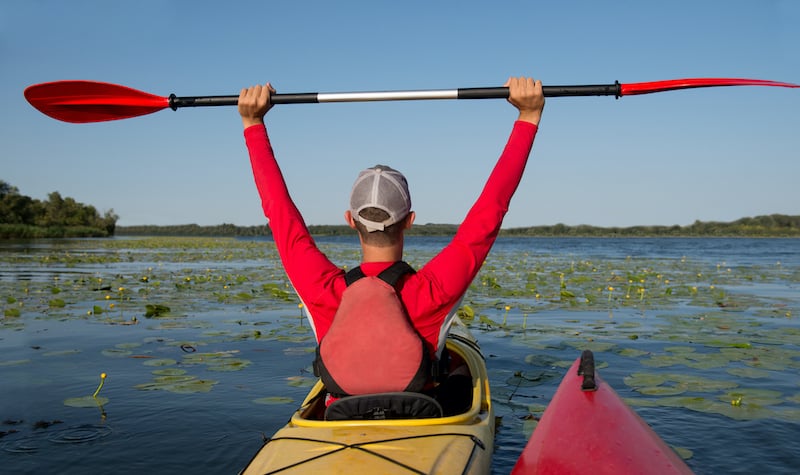Beginner paddlers put a lot of time and effort into researching and picking the perfect kayak. It’s an important choice, and the wrong boat can undoubtedly reduce your enjoyment of the sport. But in all your thorough research, don’t neglect the paddle. The lowly paddle certainly isn’t the sexiest part of kayaking, but it is the most direct connection you have to the sport and the water. Like a pair of hiking shoes, a one person’s paddle is a choice that is unique to their body, their kayak, and their style of paddling.
In this post, we’ll talk you through the different lengths and sizing options for kayak paddles to help you choose the best kayaking paddle size for you.
Why Getting the Right Length Paddle is Important

Having the right paddle is important for a few reasons. The wrong-sized paddle will cause your trouble—too short, and you may have to lean over awkwardly to avoid hitting the sides of the kayak. Too long a paddle will be heavier to hold all day and result in you doing too much work and getting tired.
How To Size a Kayak Paddle
There are several ways to go about finding the right size paddle. You can look at the manufacturer’s website and work from measurements, both of your body and your kayak. This method works best if you are ordering online and aren’t sure which one to get. You can also get your hands on the paddle at an outfitter’s shop. Even just holding the paddle can give you a pretty good idea if it will work for you or not.
Body Measurements

Probably the most critical element to sizing your kayak paddle is figuring out your body size. The higher your shoulders and elbows are off of the surface of the water, the longer the paddle you need. Some manufacturers use your overall height for simplicity. This isn’t the whole story, though, since every human is built a little differently. If you have very long legs and a short torso, you could easily wind up with a paddle that’s way too long.
Torso size is the most reliable measurement for picking your paddle. It is measured while sitting down in the paddling position from the seat to the tip of your nose.
Kayaks Width
While the type of kayak matters little for the paddle you choose, its width, also called its beam, is important. Wider boats require long paddles. Using a paddle that is too short can result in hitting the sides of the kayak with each stroke. You can measure your kayak at its widest point, or you can find its specifications online. Here’s a sample list of typical sizes, but each boat is different.
- Recreational kayaks are typically 6 to 12 feet long and 26 to 30 inches wide
- Touring kayaks are usually 12 to 15 feet long and 22 to 25 inches wide
- Performance kayaks are 15 to 18 feet long and 19 to 22 inches wide
- Whitewater kayaks tend to be 7 to 8 feet long, but the boat width isn’t as crucial as the paddlers height in these boats
Quick and Easy Sizing Methods
If you find yourself at the outfitters and you need to make a quick determination as to which paddle will work for you, there are two easy tests you can do to pick the best one. It’s handy to keep these in your back pocket if you’re renting a kayak and want to pick a paddle quickly. If you’re spending some money on a nice kayak paddle, though, you’ll probably want to research the choice even further.
The first step is to stand up with the paddle standing on end in front of you. Reach up, and see if you can place the tips of your fingers over the upper blade. If you can, it’s about right. If you can get all of your fingers over the paddle, then it’s too short, and if you can’t reach the tip at all, it’s too long.
The other test is to hold the paddle like you usually would while kayaking. Have your elbows in a comfortable position, at your sides like you would during a normal stroke. Look at where your hands lie on the shaft of the paddle. Each hand should be about two-thirds of the way between the center and the blade.
Manufacturer Recommendations
The best paddle manufacturers have useful websites that include sizing guides. They’ll guide you through the basics of how to measure your torso, height, or kayak width, but they’ll also have their own takes on which of their paddles are best for your purposes.
On-the-Water Testing Method
The absolute best way to choose the right paddle would be to take it out for a spin on the water. Sitting comfortably in your boat and making your usual style of strokes, the paddle blade should be mostly submerged and not hit the boat’s sides. If you’re buying from an outfitter that has a launch or a rental fleet, chances are they’ll let you figure out the length of the paddle that will best work for you.
Paddling Styles
There are two main styles of paddling, and each one requires a slightly different paddle. Many times kayaks alternate between the two styles, which is fine. Just pick the type of paddle that is appropriate for your style of paddling most of the time. It doesn’t mean that you can’t use that paddle otherwise.
High Angle

The angle refers to the angle the paddle shaft makes with the surface of the water. If you are a high angle paddler, you hold your paddle more vertically, with the paddle that is out of the water going over your boat or at least your shoulder. The paddle producing the power stroke is held close to the boat.
The high angle style of paddling is good for getting a lot of power from the stroke. With the blade held closer to the boat’s centerline, you can apply a lot of power without causing much turning. This is how racers or fitness paddlers do it, and it makes for a quick ride and provides a workout. Most recreational and touring kayakers only use a high angle stroke on rare occasions.
High angle paddles often have rounder blades than others. As far as the paddle size, since they’re held closer to the boat’s side, it’s easier to use a shorter paddle. If you use a longer paddle, you will be doing more work than you need to and will fatigue faster.
The standard recommendation for the average height paddler using a high angle stroke is a 210 to 220 cm paddle.
Low Angle

Low angle paddlers keep both blades of their paddles near the water. This style is the most common in touring or recreational paddling. It’s a more relaxed style with a slower cadence. For touring kayakers, a low angle reduces arm fatigue and increases endurance.
Low angle paddling is easy with a longer paddle, and it’s also more forgiving of poor paddle fit. Still, having a paddle that is way too long will feel heavy and make you tired quicker than a properly sized paddle would.
Most outfitters recommend a 230 cm paddle for standard height paddlers using low angle strokes.
Kayak Paddle Lengths
Kayak paddles are sized in centimeters—even in the United States. They are usually sold in 10-centimeter increments starting at 180 cm and going up to 250 cm. The average kayak paddle length is 230 cm, which is the recommended size for low angle, averaged height kayakers. If you’re shorter or taller, you may want to go up or down a little. If you use the high angle stroke more often, you may want a slightly shorter paddle.
Conclusion
It isn’t easy to find the perfect paddle size if you’ve never paddled before. It’s always a good idea to rent a few different kayaks or take lessons. This hands-on approach will give you an idea of what types of strokes you enjoy and how different boats handle different paddle types. When in doubt, default to the paddle manufacturer’s sizing charts to clear up any confusion.
